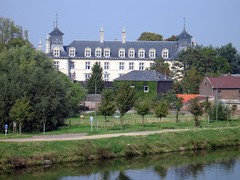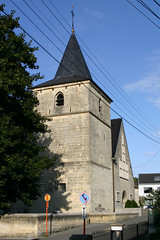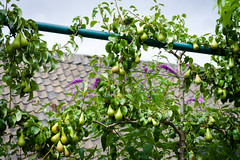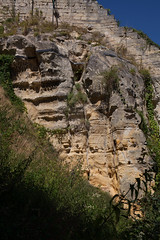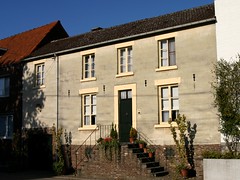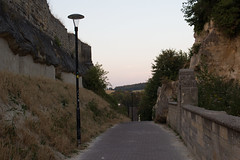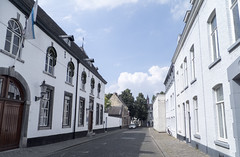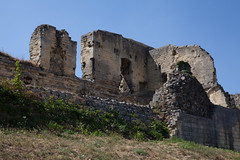Maastricht
Maastricht (English: /ˈmstrɪxt/ , English: /mˈstrɪxt/ , Dutch: [maːˈstrɪxt]; Limburgish: Mestreech Limburgish: [məˈstʀeːç]; French: Maestricht ; Spanish: Mastrique) is a city and a municipality in the southeastern Netherlands. It is the capital and largest city of the province of Limburg. Maastricht is located on both sides of the Meuse (Dutch: Maas), at the point where the Jeker joins it. Mount Saint Peter (Sint-Pietersberg) is largely situated within the city's municipal borders. Maastricht is adjacent to the border with Belgium and is part of the Meuse-Rhine Euroregion, an international metropolis with a population of about 3.9 million, which includes the nearby German and Belgian cities of Aachen, Liège and Hasselt.
Maastricht developed from a Roman settlement (Trajectum ad Mosam) to a medieval river trade and religious centre. In the 16th century it became a garrison town and in the 19th century an early industrial centre. Today, the city is a thriving cultural and regional hub. It became well known through the Maastricht Treaty and as the birthplace of the euro. Maastricht has 1677 national heritage buildings (rijksmonumenten), the second highest number in the Netherlands, after Amsterdam. The city is visited by tourists for shopping and recreation, and has a large international student population.
History
Toponymy
Maastricht is mentioned in ancient documents as ad Treiectinsem urbem ab. 575, Treiectensis in 634, Triecto, Triectu in 7th century, Triiect in 768–781, Traiecto in 945, Masetrieth in 1051.
The place name Maastricht is an Old Dutch compound Masa- (> Maas "the Meuse river") + Old Dutch *treiekt, itself borrowed from Gallo-Romance
cf. its Walloon name li trek, from Classical Latin trajectus ("ford, passage, place to cross a river") with the later addition of Maas "Meuse" to avoid the confusion with the -trecht of Utrecht having exactly the same original form and etymology. The Latin name first appears in medieval documents and it is not known whether was Maastricht's name during Roman times.
A resident of Maastricht is referred to as Maastrichtenaar whilst in the local dialect it is either Mestreechteneer or, colloquially, Sjeng (derived from the formerly popular French name Jean).
Early history
Neanderthal remains have been found to the west of Maastricht (Belvédère excavations). Of a later date are Palaeolithic remains, between 8,000 and 25,000 years old. Celts lived here around 500 BC, at a spot where the river Meuse was shallow and therefore easy to cross.
It is not known when the Romans arrived in Maastricht, nor whether the settlement was founded by them. The Romans built a bridge across the Meuse in the 1st century AD, during the reign of Augustus Caesar. The bridge was an important link in the main road between Bavay and Cologne. Roman Maastricht was relatively small. Remains of the Roman road, the bridge, a religious shrine, a Roman bath, a granary, some houses and the 4th-century castrum walls and gates, have been excavated. Fragments of provincial Roman sculptures, as well as coins, jewelry, glass, pottery and other objects from Roman Maastricht are on display in the exhibition space of the city's public library (Centre Céramique).
According to legend, the Armenian-born Saint Servatius, Bishop of Tongeren, died in Maastricht in 384 where he was interred along the Roman road, outside the castrum. According to Gregory of Tours it was bishop Monulph who around 570 built the first stone church on the grave of Servatius, a precursor of the present-day Basilica of Saint Servatius. The city remained an early Christian diocese until it lost the distinction to nearby Liège in the 8th or 9th century.
Middle Ages
In the early Middle Ages Maastricht, along with Aachen and Liège, formed part of what is considered the heartland of the Carolingian dynasty. At this time, the town was an important centre for river trade and manufacturing. Merovingian coins minted in Maastricht have been found throughout Europe. In 881 the town was plundered by the Vikings. In the 10th century it briefly became the capital of the duchy of Lower Lorraine.
During the 11th and 12th centuries the town flourished culturally. Several provosts of the chapter of Saint Servatius held important positions in the Holy Roman Empire. The two collegiate churches were largely rebuilt and redecorated during this era. Maastricht Romanesque stone sculpture and silversmithing are regarded as highlights of Mosan art. Maastricht painters were praised by Wolfram von Eschenbach in his Parzival. Around the same time, the poet Henric van Veldeke wrote a legend of Saint Servatius, one of the earliest works in Dutch literature. The two main churches acquired a wealth of relics and the septennial Maastricht Pilgrimage became a major event that drew up to 100,000 pilgrims.
Unlike most Dutch towns, Maastricht did not receive city rights at a certain date. These gradually developed during its long history. In 1204 the city's dual authority was formalised in a treaty, with the prince-bishop of Liège and the duke of Brabant holding joint sovereignty over the city. Soon afterwards the first ring of medieval walls were built. In 1275, the old Roman bridge collapsed under the weight of a procession, allegedly killing 400 people. A replacement bridge, funded by church indulgences, was built slightly to the north and survives until today, the Sint Servaasbrug.
Throughout the Middle Ages, the city remained a centre for trade and manufacturing principally of wool and leather but gradually economic decline set in. After a brief period of economic prosperity around 1500, the city's economy suffered during the wars of religion of the 16th and 17th centuries, and recovery did not happen until the industrial revolution in the early 19th century.
16th to 18th centuries
The strategic location of Maastricht at a major river crossing necessitated the construction of an array of fortifications around the city during this period. The Spanish and Dutch garrisons became an important factor in the city's economy. In 1579 the city was sacked by the Spanish army led by the Duke of Parma (Siege of Maastricht, 1579). For over fifty years the Spanish crown took over the role previously held by the dukes of Brabant in the joint sovereignty over Maastricht. In 1632 the city was conquered by Prince Frederick Henry of Orange and the Dutch States General replaced the Spanish crown in the joint government of Maastricht.
Another Siege of Maastricht (1673) took place during the Franco-Dutch War. In June 1673, Louis XIV laid siege to the city because French supply lines were being threatened. During this siege, Vauban, the famous French military engineer, developed a new tactic in order to break down the strong fortifications surrounding Maastricht. His systematic approach remained the standard method of attacking fortresses until the 20th century. On 25 June 1673, while preparing to storm the city, captain-lieutenant Charles de Batz de Castelmore, also known as the comte d'Artagnan, was killed by a musket shot outside the Tongerse Poort. This event was embellished in Alexandre Dumas' novel The Vicomte de Bragelonne, part of the D'Artagnan Romances. French troops occupied Maastricht from 1673 to 1678.
In 1748 the French again conquered the city at what is known as the Second French Siege of Maastricht, during the War of Austrian Succession. After each siege the city's fortifications were restored and expanded. The French revolutionary army failed to take the city in 1793 but a year later they succeeded. The condominium was dissolved and Maastricht was annexed to the French First Republic, later the First French Empire. For almost twenty years (1795–1814/15) Maastricht was the capital of the French département of Meuse-Inférieure.
19th and early 20th century
After the Napoleonic era, Maastricht became part of the United Kingdom of the Netherlands in 1815. It was made the capital of the newly formed Province of Limburg (1815–1839). When the southern provinces of the newly formed kingdom seceded in 1830, the Dutch garrison in Maastricht remained loyal to the Dutch king, William I, even when most of the inhabitants of the town and the surrounding area sided with the Belgian revolutionaries. In 1831, arbitration by the Great Powers allocated the city to the Netherlands. However, neither the Dutch nor the Belgians agreed to this and the arrangement was not implemented until the 1839 Treaty of London. During this period of isolation Maastricht developed into an early industrial town.
Because of its eccentric location in the southeastern Netherlands, as well as its geographical and cultural proximity to Belgium and Germany, integration of Maastricht and Limburg into the Netherlands did not come about easily. Maastricht retained a distinctly non-Dutch appearance during much of the 19th century and it was not until the First World War that the city was forced to look northwards.
Like the rest of the Netherlands, Maastricht remained neutral during World War I. However, being wedged between Germany and Belgium, it received large numbers of refugees, putting a strain on the city's resources. Early in World War II, the city was taken by the Germans by surprise during the Battle of Maastricht of May 1940. On 13 and 14 September 1944 it was the first Dutch city to be liberated by Allied forces of the US Old Hickory Division. The three Meuse bridges were destroyed or severely damaged during the war. As elsewhere in the Netherlands, the majority of Maastricht Jews died in Nazi concentration camps.
After World War II
During the latter half of the century, traditional industries (such as Maastricht's potteries) declined and the city's economy shifted to a service economy. Maastricht University was founded in 1976. Several European institutions found their base in Maastricht. In 1981 and 1991 European Councils were held in Maastricht, the latter one resulting a year later in the signing of the Maastricht Treaty, leadi…
Looking for places related to Maastricht?
Those are other destinations to find places related to Maastricht:



